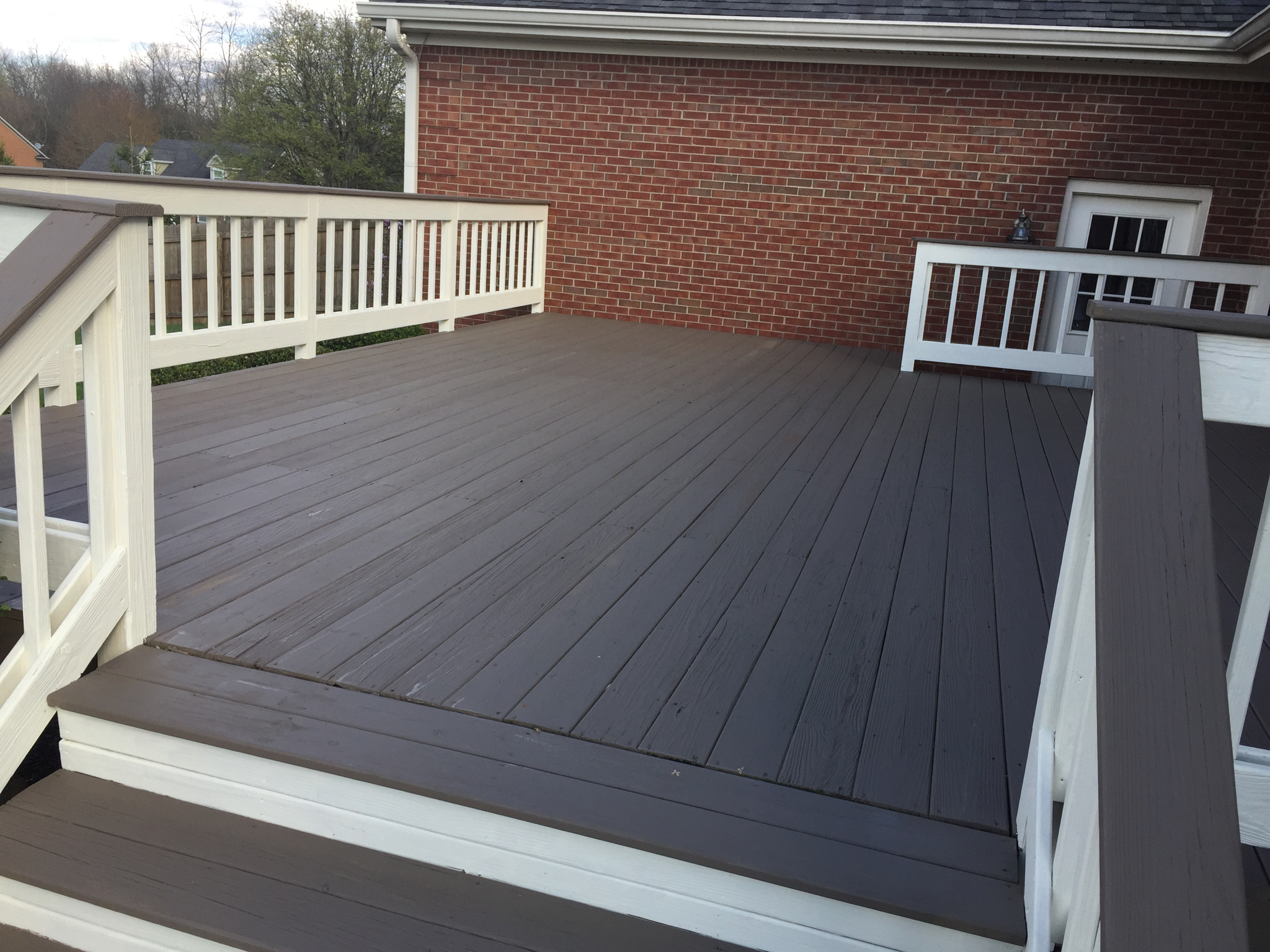Maintain and Enhance: Introducing the Art of Fence Staining
Wiki Article
Selecting the Right Stain for Your Fencing: Tips and Considerations
When it comes to enhancing the appearance and maintaining of your fencing, selecting the ideal tarnish is vital. We will certainly discover the various kinds of fencing stains, elements to think about before choosing a discolor, pointers for preparing your fencing for discoloration, and the differences between water-based and oil-based discolorations. In addition, we will certainly dive right into selecting the best discolor color to enhance your fence and boost your outdoor room.Recognizing Various Kinds of Fencing Discolorations

On the various other hand, water-based discolorations are made from acrylic or latex and use an extra subtle color to the wood. They produce a protective movie on the surface of the timber, preventing dampness from leaking in and shielding against UV damages. Water-based discolorations are less complicated to tidy up and have a quicker drying out time contrasted to oil-based discolorations. They are additionally less most likely to fracture or discolor with time.
Selecting in between water-based and oil-based discolorations relies on numerous variables, including personal preference, the desired look, and the degree of upkeep required. Oil-based stains are recommended for fences in high-traffic locations or those frequently revealed to extreme weather problems. deck staining. Water-based discolorations, on the various other hand, are a prominent option for fence houses where look and convenience of use are necessary
When choosing the right tarnish for their fence,Recognizing the distinctions between water-based and oil-based spots helps house owners make an informed choice. Thinking about the specific demands of the fence, such as its area, exposure to sunshine, and desired visual, will make certain that the selected tarnish offers long-lasting security and enhances the general elegance of the fence.
Factors to Take Into Consideration Before Picking a Stain

Another variable to think about is the sort of timber your fencing is constructed from. Different sorts of timber take in stains differently, leading to varying degrees of color strength and durability. Softwoods like yearn might need more frequent discoloration compared to woods like cedar or redwood. Furthermore, certain woods might be much more susceptible to issues like rot or insect problem, which may influence the choice of discolor to protect the fencing and safeguard.
The environment and climate condition in your area must additionally be thought about. If you reside in an area with extreme winters months or high moisture, you may need a discolor that supplies added defense versus dampness and UV rays. Likewise, if your fence is subjected to guide sunshine for lengthy periods, a tarnish with UV inhibitors can help prevent fading and staining.
Finally, it's essential to consider your wanted visual. Different stains provide different shades and surfaces, allowing you to tailor the look of your fence (fence staining). Take into consideration the general design and style of your residential or commercial property, as well as any kind of local regulations or homeowner organization guidelines that might determine the acceptable tarnish colors
Tips for Preparing Your Fencing for Staining
Cleansing the fence is a crucial step as it gets rid of dirt, gunk, and any kind of previous coatings that might interfere with the discoloration procedure. Scrub the surface carefully, paying additional focus to areas with persistent stains or mold.After cleansing, allow the fence to dry entirely. deck staining. This step is vital as staining a damp or wet surface can cause inadequate attachment and an uneven surface. Depending upon the weather, it may take anywhere from a few hours to a few days for the fence to dry completely. Make certain that the fence is completely dry before proceeding with the staining process.
Before staining, evaluate the fencing for pop over to these guys any type of damages, such as loosened boards or nails. This product aids to open up the wood pores, enabling the tarnish to penetrate more effectively and equally.

Comparing Water-Based and oil-based Discolorations
When selecting a discolor for your fence, it is essential to compare the qualities and advantages of water-based and oil-based stains. Both sorts of discolorations have their own advantages and factors to consider, so it is vital to understand the differences between them.Oil-based discolorations are recognized for their sturdiness and resistance to tear and put on. They pass through deeply into the wood, supplying superb protection against the elements. They likewise improve the all-natural elegance of the timber by highlighting its grain and texture. Additionally, oil-based spots have a tendency to last longer than water-based discolorations, making them a popular choice for fences.
On the other hand, water-based discolorations are a lot more eco pleasant and much easier to clean up. They might not supply the exact same level of defense as oil-based discolorations, specifically in rough weather condition conditions.
Inevitably, the option in between water-based and oil-based spots depends on your certain needs and choices. When making your choice, take into consideration elements such as durability, environmental influence, and simplicity of application. Consulting with a specialist or looking for recommendations from professionals can additionally assist make sure that you choose the ideal stain for your fencing.
Choosing the Right Spot Shade for Your Fence
The choice of an ideal discolor shade for your fence is a crucial facet of enhancing its visual allure and matching the overall style of your outdoor area (fence staining and sealing). The ideal discolor shade can change a plain, ordinary fencing into a striking focal factor that adds deepness and character to your buildingWhen picking a discolor shade for your fence, it is essential to think about the style and style of your home. Natural tones such as browns and neutrals can produce a cozy and welcoming appearance if you have a conventional or traditional style home. On the various other hand, if you have a modern or contemporary home, you may take into consideration selecting strong and vivid colors that make a statement.
An additional factor to think about is the natural environments of your property. If you have a great deal of greenery, a discolor shade that complements the natural landscape, such as eco-friendlies or crimsons, can develop a unified and natural look.
Furthermore, it's worth considering the upkeep needed for various tarnish shades. Lighter shades tend to show dust and put on more quickly, while darker colors can hide flaws and need less regular touch-ups.
Eventually, the option of tarnish shade for your fencing need to mirror your individual design and choices - fence staining and sealing. Put in the time to speak with and check out different choices with experts if required, to ensure that you select the ideal discolor shade that enhances the charm and charm of your fencing
Verdict
Finally, when it comes to choosing the right stain for your fence, it is crucial to recognize the various kinds of discolorations readily available and consider factors such as sturdiness and preferred look. Preparing the fencing effectively prior to discoloration is vital for attaining optimum results. Furthermore, contrasting water-based and oil-based stains can assist identify the finest alternative for your details needs. Choosing the appropriate tarnish color can boost the total appearances of your fencing.We will certainly check out the different kinds of fence spots, elements to take into consideration before picking a discolor, tips for preparing your fencing for staining, and the differences in between oil-based and water-based spots.Setting apart between water-based and oil-based stains is critical when comprehending various types of fencing spots. Water-based discolorations are much easier to cleanse up and have a faster drying out time contrasted to oil-based spots. In addition, oil-based stains often tend to last longer than water-based stains, making them a prominent choice for fences.
In verdict, when it comes to picking the best tarnish for your fencing, it is essential to recognize the different types of spots readily available and consider elements such as longevity and desired look.
Report this wiki page